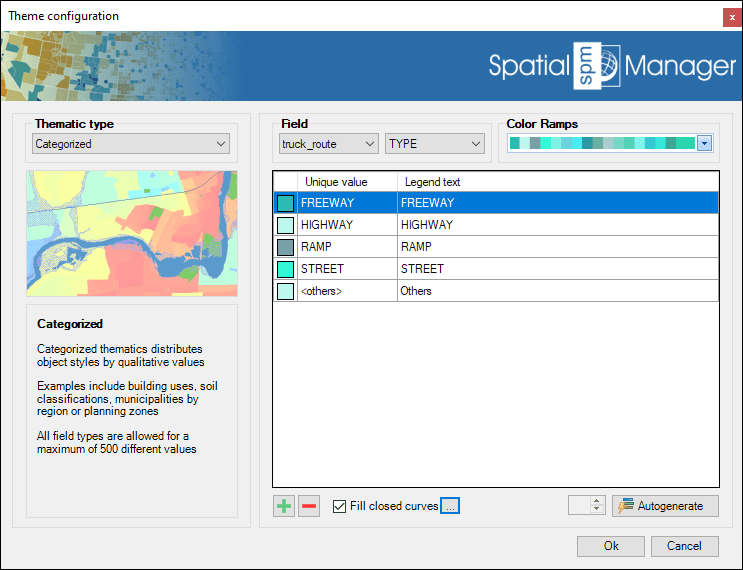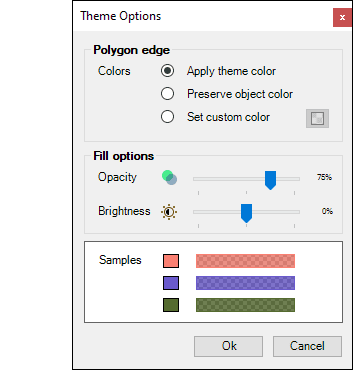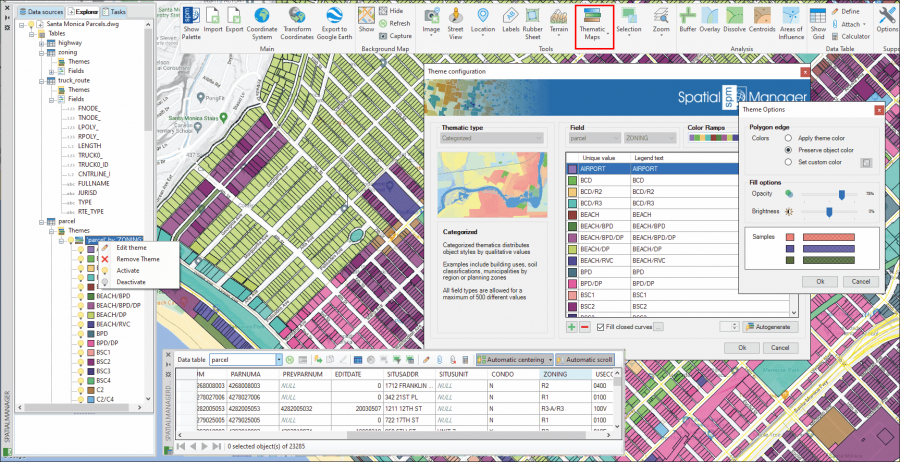Spatial Manager™ for AutoCAD - FAQs: Thematic Maps ("Professional" edition only)
Notes:
- Some components in the images on this page (providers, names, windows look, etc.) may be slightly different from those that will appear on your computer
- Some application functions need to access the Internet from the application itself. If you experiment problems in any process, ask your network administrator if there is a Proxy server installed on your network. You can configure the Proxy settings through the application options
- Some geographic data providers (Geocode, image Maps, etc.) may need a user account, which you can configure in the Service Provider API Keys settings through the application options
Introduction
- Objective of this section
- To learn how to change the visual appearance of objects depending on the values of a data field of an associated table (Thematic Map)
- Topics in this section
- Definition of new Thematic Maps
- Choose the type of a new Thematic Map
- Auto-generation of Styles
- Styles creation, deletion and editing
- Thematic colors of objects and optional fills
- Management of Thematic Maps from the application Explorer
- Activation and deactivation of Thematic Maps
How can I graphically represent in the drawing the Data values attached to the objects?
Spatial Manager™ for AutoCAD includes the Thematic Maps functionality, which allows to temporarily change the objects color in the drawing according to their associated alphanumeric data. You can define a new Thematic Map using the 'SPMTHEMATICMAP' command, whose window includes the definition of all the necessary parameters and options, as you can read below
In a drawing you can define as many Thematic Maps as you wish and activate or deactivate (return the display of objects to its normal state) the Maps or any of the Styles. In addition, you can edit the colors and names of the Styles, and the visual update of the objects is Dynamic, i.e. if data values are modified while a Thematic Map is active, the colors will automatically change to reflect the new values of the affected objects

Thematic Maps in a drawing

In the Thematic Map definition (and edition) window all the parameters and options of the Map are specified:
- Thematic type
- Categorized: Distributes object Styles by Qualitative values. Examples include building uses, soil classifications, municipalities by region, or planning zones. All field types are allowed for a maximum of 500 different values
- Graduated: Distributes object Styles considering value Ranges. Examples include rivers by flow, buildings by height, or urban areas by population density. Numeric fields (including date/time) are allowed
- Graduated Gradient: Distributes object Styles considering value/color Ranges, creating one or more Gradients. Examples include altimetry representations, or heat maps. Numeric fields (including date/time) are allowed

- Field
- Field in a Table whose values will be represented by the Thematic Map
- Color Ramps
- Although you can manually define and edit the Colors of each Style, the application includes a large number of predefined Color Ramps (single colors, gradients, etc.) that can be selected to assign these Colors. Even after selecting a Color Ramp, the Colors can be modified by the user for one more Styles of the Thematic Map
- Styles table
- Include the Color, Value (unique or values range) and Legend text for each Style in the Thematic Map. All these parameters can be customized
- The buttons below this table allow you to manually Add or Remove Styles. The Autogenerate button will automatically create the Styles of the Thematic Map for you based on the Values of the chosen field. In the case of Graduated Thematics, it is possible to define the number of "steps" in the range of the field Values
- In addition, it is possible to select whether to automatically Fill the closed objects that are part of the Thematic. In this case, the following options are available:
- Polygon edge
- Apply theme color: The object Edges will be displayed in the color defined in the corresponding Style
- Preserve object color: The objects Edges will be displayed in their drawing color regardless of the color defined in the Style that corresponds to them
- Set custom color: A Custom color can be selected for all object Edges regardless of the color defined in the Style that corresponds to them
- Fill options
- Here you can define the Opacity and Brightness levels for the resulting Hatches
- Polygon edge

xxx
Related links
- Blog posts
